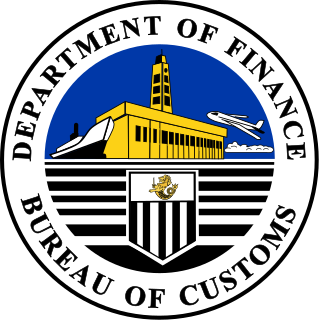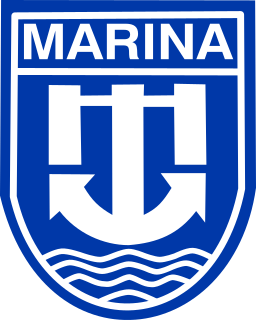Transportation in Puerto Rico includes a system of roads, highways, freeways, airports, ports and harbors, and railway systems, serving a population of approximately 4 million year-round. It is funded primarily with both local and federal government funds.

Freedom of the seas is a principle in the international law and sea. It stresses freedom to navigate the oceans. It also disapproves of war fought in water. The freedom is to be breached only in a necessary international agreement.

The United States Customs Service was an agency of the U.S. federal government that collected import tariffs and performed other selected border security duties.

The Merchant Marine Act of 1920 is a United States federal statute that provides for the promotion and maintenance of the American merchant marine. Among other purposes, the law regulates maritime commerce in U.S. waters and between U.S. ports. Section 27 of the Merchant Marine Act is known as the Jones Act and deals with cabotage and requires that all goods transported by water between U.S. ports be carried on U.S.-flag ships, constructed in the United States, owned by U.S. citizens, and crewed by U.S. citizens and U.S. permanent residents. The act was introduced by Senator Wesley Jones. The law also defines certain seaman's rights.
The Passenger Vessel Services Act of 1886 is a protectionist piece of United States legislation which came into force in 1886 relating to cabotage. Essentially, it says:
No foreign vessels shall transport passengers between ports or places in the United States, either directly or by way of a foreign port, under a penalty of $200 for each passenger so transported and landed.
Cabotage is the transport of goods or passengers between two places in the same country by a transport operator from another country. It originally applied to shipping along coastal routes, port to port, but now applies to aviation, railways, and road transport as well.
The modern terms short sea shipping,marine highway and motorways of the sea refer to the historical terms coastal trade, coastal shipping, coasting trade and coastwise trade, which encompass the movement of cargo and passengers mainly by sea along a coast, without crossing an ocean. 'Deep-sea shipping', 'intercontinental shipping' or 'ocean shipping' refers to maritime traffic that crosses oceans. While 'short-sea shipping' is the term used in Europe, the United States also has used the term, 'marine highway'.

The Philippine Coast Guard (PCG) is an armed and uniformed service tasked primarily with enforcing laws within Philippine waters, conducting maritime security operations, safeguarding life and property at sea, and protecting marine environment and resources; similar to coast guards around the world.

Port security refers to the defense, law and treaty enforcement, and counterterrorism activities that fall within the port and maritime domain. It includes the protection of the seaports themselves, the protection and inspection of the cargo moving through the ports, and maritime security.
The flag state of a merchant vessel is the jurisdiction under whose laws the vessel is registered or licensed, and is deemed the nationality of the vessel. A merchant vessel must be registered and can only be registered in one jurisdiction, but may change the register in which it is registered. The flag state has the authority and responsibility to enforce regulations over vessels registered under its flag, including those relating to inspection, certification, and issuance of safety and pollution prevention documents. As a ship operates under the laws of its flag state, these laws are applicable if the ship is involved in an admiralty case.
The Maritime Transportation Security Act of 2002 (MTSA) is an Act of Congress enacted by the 107th United States Congress to address port and waterway security. It was signed into law by President George W. Bush on November 25, 2002.

The Steamboat Inspection Service was a United States agency created in 1871 to safeguard lives and property at sea. It merged with the Bureau of Navigation in 1932 to form the Bureau of Navigation and Steamboat Inspection which, in 1936, was reorganized into the Bureau of Marine Inspection and Navigation, which in turn came under the control of the United States Coast Guard in 1942 and was abolished, with its functions transferred to the Coast Guard, in 1946.

The Port of Manila refers to the collective facilities and terminals that process maritime trade function in harbours that serve the Metro Manila Area. It is located in the Port Area and Tondo area of Manila, Philippines facing the Manila Bay. It is the largest and the premier international shipping gateway to the country. The Philippine Ports Authority, a government-owned corporation, manages the Port of Manila and most of the public ports in the country. It is composed of 3 major facilities namely Manila North Harbor, Manila South Harbor and the Manila International Container Terminal.

The Port of Zamboanga and is a seaport located in Zamboanga City, Philippines. It is managed by the Zamboanga City Special Economic Zone Authority (Zamboecozone), otherwise known by its corporate name, Zamboanga Freeport Authority (ZFA). The facility ranked second in Asia under the Super Efficient Ports in Asia study carried out in 2010 and published in the African Journal of Business Management on February 18, 2011.

The Port of Iloilo in Iloilo City, Philippines, serves the province and city of Iloilo and the entire Panay Island, in Western Visayas of the Philippines. It is located away from the older port facilities on the Southern coast of Panay Island, in the Panay Gulf, and one of the country’s safest and most natural harbors. Guimaras Island shields the port from violent storms and makes it ideal for harboring ships and vessels.

PMI Colleges, formerly known as Philippine Maritime Institute, is a private, non-sectarian, co-educational higher education, Maritime institution established on September 18, 1948 in Sta. Cruz, Manila, Philippines where its main campus is located.

Filipino seamen, also referred to as Filipino seafarers or Filipino sailors, are seamen, sailors, or seafarers from the Philippines. Although, in general, the term "Filipino seamen" may include personnel from the Philippine Navy or the Philippine Marine Corps, it specifically refers to overseas Filipinos who are "sea-based migrant Filipino workers".

The Batangas International Port or locally known as the Batangas Pier, is a seaport in Barangay Santa Clara, Batangas City primarily serving the Calabarzon region of the Philippines. The seaport covers an area of about 150 hectares.

The Bureau of Customs is a Philippine government agency under the Department of Finance.
















